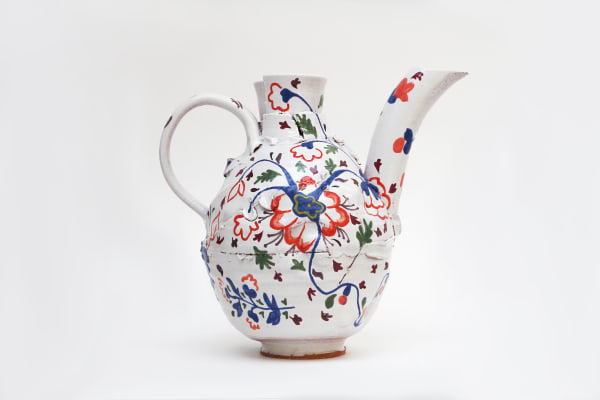MIND THE GAP: Elin Hughes and Spencer Shakespeare | Floor 2
Both these artists have presented new works which remind us that the illusion of lightness in painting or patterning is achieved by careful consideration of negative space.
Spencer Shakespeare is evangelical in his approach to painting and in his own life. He seeks the light and his latest paintings have an airiness - his marks stand alone, without the need to draw and colour every inch of space. Shakespeare has forsaken the decorative appropriation of modernism, except for Picasso, who touches his right shoulder.
Elin is a Spring goddess, making vases, breaking vases and reconstructing vessels with such jauntiness and fluency of historical referencing they make the heart sing. Her new pots pay homage to the cobalt blue and iron red foliage and flowers motifs on Victorian Gaudy Welsh pottery, English and continental Imari ware. Elin has sourced designs but her flowers are hand drawn; revived and relaxed they have broken free from 18c pattern books. Feminine whimsy is personified in a teapot like vessel with a spout, handle and complementary nipple,
wide-bosomed Gaia
Elin Hughes
Elin Hughes likes to get physical. She likes to punch her wheel thrown pots, slicing and pounding the soft clay until the original form is defeated. Then, Hughes deliberately reconstructs the broken vessel in a rough hewn way - like the Japanese fashion designer who deconstructs a jacket and wears it inside out in a search for abstract purity.
Non functional pots are rooted in 20th century modernist philosophy and practice: Elin Hughes quotes Martin Heidegger “the potters medium is not clay but space.” In abstract art the medium is the message and pots without a function rely on the skilful manipulation of clay to goad and tickle our senses and ignite our suggestive memory: they are also beautiful to look at, each angle revealing a different picture - light and shade on shape and space. Full of character these pots make us smile and if Picasso was alive he would delight in Elin’s quirky cubisim - in the 1940s Pablo Picasso was creating and decorating ceramics with majolica tin glazes which mirrored the bright colours of the Mediterranean. Elin’s ideas might be contemporary but her decorative techniques were all the rage in medieval Europe. Her translucent jewel colours are achieved by tin-glazing earthenware and firing it a second time. This technique originates in the Middle East in the 9th century. Majolica ware, named after the island of Majorca, was made by 14th and 15th century Spanish and Italian potters. In Victorian England majolica ware was first shown at the Great Exhibition of 1851. The public loved it so much that china factories Minton and Wedgwood were able to mass produce the functional and cheap majolica which can still be seen on granny’s window sill, charity shops and car boot sales.
Spencer Shakespeare
Born in 1967 in London, Shakespeare discovered his addiction to the natural world in his yearly holidays to Cornwall with his family, which, after 20 years of living on Australia's Gold Coast he has returned to, residing near Penzance where he says the bird song is at its most beautiful. Being an obsessive and automatic drawer since the age of seven, Shakespeare completed a degree in Illustration at Bournemouth College of Art and Design (1992-1995). Although his love of drawing never stopped, as he matured both as a person and an artist, he sought to break away from commissioned work, seeking his own artistic independence. Now an internationally successful artist, independence is what he has certainly achieved.
He enjoys transcribing places of intersection; the coastline, the edge of forests- places where a transition of boundaries takes place. The garden is significant in his work because of the element of interchange between the domestic boundary and the beginning of wilderness. Although he is inspired by places such as these, he never strives for specifics nor is beholden to the landscape around him, instead drawing and exposing his own imaginary world. His work connotes a kind of mystery, a kind of magic. A world where colours are intense, high contrast, energetic: vibrating with an emotional energy. His abstract canvases show the blurred boundaries of the humming world he sees: a door for you, the viewer, that opens into wonderland.
All artworks will be available to view on floor 2 and online from the May 03.








